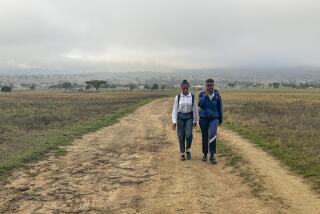Egypt Bets on Schools for Girls
- Share via
TANAN, Egypt — In this scruffy Nile Delta village, where the narrow alleys are congested with men in robes, black-draped women carrying babies, chickens scrabbling for food and flyspecked carcasses hanging out for sale, it’s easy for young girls to get mired.
Caught in a rural backwater, held down by low expectations, they are mired most of all by ignorance.
That was the fate that awaited Nadia Hosny, a teenager who was earlier barred from attending school by her father, making her one of an estimated 73 million school-age girls in developing nations worldwide denied a basic education.
Nadia was bound for a life of illiteracy and limited skills because of conservative beliefs, prevalent in parts of rural Egypt and many developing countries, that school is vital for boys but less so for girls.
Then, the government in Cairo started a system of all-girl schools. And at age 11, Nadia persuaded her father to let her enter first grade.
“Before, I could not even write my name,” she said recently, sitting primly in a classroom here. “Now, I can read and write, just like any other girl who is educated.”
Her father is “very proud of me,” Nadia said. Her eyes blazing with determination, the 16-year-old added: “I will go as far as I can go.”
In the Middle East, sub-Saharan Africa and South Asia, there is a gaping disparity between the proportion of boys and girls educated. In Egypt, 64% of boys and men age 15 and older can read and write, while fewer than 39% of girls and women can.
UNICEF reported last month that an estimated 855 million people--nearly one-seventh of humanity--are approaching the new millennium functionally illiterate. Two-thirds of them are women and girls, the agency reported.
Aside from the individual cost--so many lives tragically limited by the inability to understand a street sign or food label, write a message or calculate a three-digit sum--experts believe that keeping so many of the developing world’s girls in ignorance holds back their societies from improving standards of living, reducing population growth and fighting problems such as infant and child mortality.
Educated girls marry later, have fewer children, seek medical attention sooner and know how to provide better care and nutrition, according to the UNICEF report. If a country increases by 10 percentage points the enrollment of girls in primary schools, infant mortality can be expected to fall by 4.1 deaths per 1,000 births, the agency said.
“For millions and millions of children,” said UNICEF Executive Director Carol Bellamy as she issued the report, “education is literally a matter of life and death.”
So in Egypt and dozens of other countries, educators and nongovernmental organizations in the 1990s have searched for ways to reach out to girls and get them into the classroom.
In the process, they have often had to confront entrenched beliefs, especially in rural areas, that girls belong in the home, and have had to provide schools that are more acceptable to girls’ parents.
Government Made Decision in 1993
That’s where Nadia’s success story comes in.
Nadia probably would not have entered school but for a 1993 decision by the government. In a bid to reverse the widespread problem of female illiteracy, Egypt established a parallel system of one-room schoolhouses for girls whose parents, for reasons of religion and morality, did not want them educated with boys in the nation’s regular schools, where girls now make up more than 46% of the student body.
The parallel system is now educating 30,000 girls.
These vest-pocket schools are kept small so that they can be located closer to the girls’ homes, and usually are staffed by teachers from the same village to allay paternal concerns that the local norms of decency and modesty will not be respected.
While the schools in general have been praised, some feminists in Egypt have reservations. They fear that by accommodating rural parents’ fears about coed education, the state is embracing archaic views about girls and surrendering to extreme Islamist thinking.
According to Samir Moustafa, the Education Ministry’s director of curriculum for the one-room schools, girls are denied an education for a combination of economic and social reasons: Fathers do not want their daughters to mix with boys in classrooms or to be left under the tutelage of male teachers; some fear that girls may dishonor the family if they travel unsupervised between home and school; families feel that the girls are needed to work at home; some believe that whatever money the family has would be better spent on boys.
In rural Upper Egypt, the area where the country’s extreme Islamist movement is considered strongest, about a quarter of the children live 1.8 miles or more from the nearest village school, according to UNICEF. Many conservative, low-income fathers in these areas simply will not let their daughters travel such a distance to go to a school that they may not trust or can ill afford. In some remote hamlets, the result is only 12 girls attending the regular school for every 100 boys.
Egypt’s one-room schools are meant to address the needs of such girls. The schools, for grades one through five, are free of fees and staffed exclusively by women, and they aim to provide basic education and practical, potentially income-producing skills.
“If the regular school doesn’t work for these girls, I’m trying to give them an alternative,” said Ragab Sharaabi, the deputy minister of education.
Why are girls so habitually denied educational opportunity? As journalist Soha Abdel Kader pointed out in her women-oriented column in Al Ahram newspaper last year, discrimination against girls is a pervasive fact of life in Egypt.
“That there is a clear preference for male children among Egyptians, especially men, is a well-established fact,” she said, noting that a boy child is considered such a treasure to his family that he receives the best of everything that is available--food, clothing, medical care, education.
The result is “phantom” girls who are missing from the rolls of the nation’s regular school system. Although girls make up 46.5% of the student population, they constitute 49% of the school-age population, according to official statistics. With about 14.5 million pupils enrolled in this country of 67 million people, that suggests that there are hundreds of thousands of girls not enrolled.
That gender gap in education holds true for most countries in the Middle East and North Africa.
Egypt’s first lady, Suzanne Mubarak, who has made fighting illiteracy one of her chief causes, is an enthusiastic backer of the one-room-school idea. The system has more than 2,000 schools and is expanding toward a goal of 3,000. In most places where they exist, the all-girl schools have waiting lists.
Education officials see the schools as an important long-range tool for fighting illiteracy because they believe they will produce educated girls who later will ensure that their own children will be literate.
“When you teach a man, you teach one person. When you teach a woman, you teach 10,” said Moustafa, who drafted the curriculum for the one-room schools.
But Egyptian feminist and novelist Nawal Saadawi said she considers the all-girl model inadequate. She said she fears that the state is pandering to “religious fanatics” rather than fighting for a more liberated society.
“I am very much against girls being educated alone,” Saadawi said. “I am for coeducation from the beginning of school all the way to university. Boys and girls are together on the streets and everywhere else, so why should we separate them in education? It’s very unnatural.”
Egypt, however, considers the schools a showpiece in its effort to improve the country’s literacy. “The program has succeeded in closing a dangerous loophole of illiteracy,” said Sharaabi of the Education Ministry. “It has helped to mold a good citizen who can be the mother of future generations of Egyptians.”
Once the girls are in school, he said, they are exposed to “new notions”: information about such topics as family planning, health and hygiene, protecting the environment and eradicating the still-widespread practice of female genital excision.
The schools accept girls between 8 and 15 who have been kept out of the regular public schools and are therefore usually old for their grade level. Under a new decree, the girls who complete the five-year primary program may enter a coeducational secondary school if they wish, as long as they are still younger than 18. Of the first 1,500 girls who finished the one-room school program, in June, 600 have elected to go on with their schooling.
Small Tableaux of Hope Are on Display
The 1,700-square-foot Tanan School has 35 students and three teachers. Its walls are brightly decorated with items the pupils have made--dresses, knitted goods and floral arrangements that are later sold to the community to raise additional money for the school.
The pupils sit at desks arranged in semicircles according to grade level. One teacher gives instruction to the lower grades; another, the upper grades; and a vocational instructor teaches skills such as sewing, cooking, canning, growing food plants and raising animals. A small library--a cupboard filled with books--stands in one corner.
The curriculum is similar to that of the coed schools, although vocational training takes the place of physical education, art and music.
The classroom offers small tableaux of hope. While the bare skills imparted may seem rudimentary, the simple abilities to read and write, operate a sewing machine, use a stove and preserve fruits and vegetables are enough to give the girls confidence and a chance for work other than that of a farm laborer or domestic servant, said vocational teacher Hoda Hosny.
Hosny, who is from Tanan but is not related to Nadia, treats her charges with obvious affection and pride. In fact, she has sewn a uniform for each.
Several described being aided by their mothers to overcome their fathers’ initial resistance to the school. “My mother is still illiterate,” said Sama Moustafa Mohammed, a 13-year-old entering first grade. “But she said I should go and have the chance that she did not.”
According to teachers, these girls given a second chance at education learn quickly, both because they are older than most primary students and because they are more motivated.
Nadia, who now reads for pleasure, and is learning to speak English, said the school has broadened horizons for her.
When she was asked what she would like to do with her education, the answer came quickly: “I would like to be a teacher--for example, in a one-classroom school like this.”
Aline Kazandjian of The Times’ Cairo Bureau contributed to this report.
More to Read
Sign up for Essential California
The most important California stories and recommendations in your inbox every morning.
You may occasionally receive promotional content from the Los Angeles Times.













